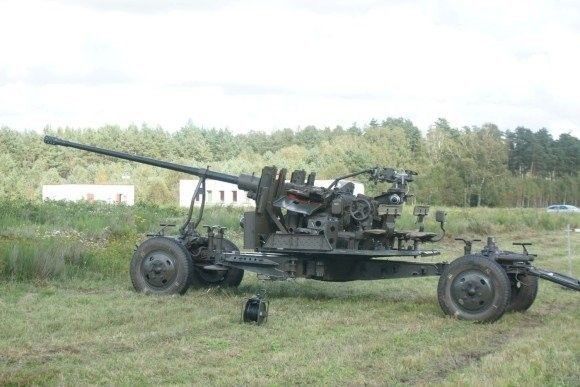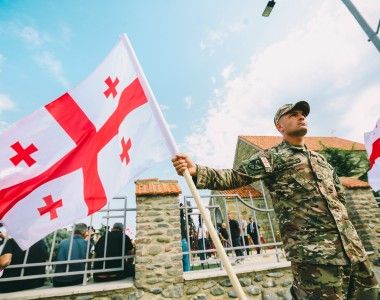Poland Sends Anti-Aircraft Artillery To Ukraine. What Are the Specific Types?

Photo. Jarosław Ciślak/Defence24
Last Thursday a declaration was published in Tallinn, concerning another military aid package for Ukraine. The UK, Denmark, Czech Republic, Slovakia, Lithuania, Latvia, Estonia, and Poland can be found among the contributing nations. Poland declared it would transfer its 57 mm S-60 anti-aircraft guns, with 70,000 rounds of ammo.
The declaration unveiled does not list the specific number and variants of the S-60 anti-aircraft gun. The statements may refer to the classic S-60, or the seriously upgraded S-60MBs, operated by the Polish Navy.

Photo. Jarosław Ciślak/defence24.pl
The 57 mm automatic S-60 anti-aircraft gun was being license-manufactured at ZM Tarnów, based on a Soviet license. 680 examples were manufactured there, between 1958 and 1964. The guns were received by the land forces, air defence units, and by the Navy. On 1st January 1988, 198 were available in peacetime, and after wartime mobilization, that number went up to 560.
The Air Defence component operated 66 examples across 6 batteries (6 in each battery), the Navy had an inventory of 72 examples, spread across 3 artillery squadrons (24 per squadron), while the Army was using the remaining guns. These were primarily used by AAA regiments of the mechanized divisions that had not received the Kub and Osa SAM systems. Mobilized AAA regiments of the reserve mechanized divisions also used the S-60s during wartime.
HE and AP-Frag warheads were used in the ammo for the S-60 gun. Back in the Warsaw Pact era, a Soviet ammo unit for a single gun included 200 rounds, including 190 HE, and 10 AP rounds. Each gun was equipped with 9 units as such.

Photo. Jarosław Ciślak/defence24.pl
The targeting and reloading processes were all manual. Waza radar was used to guide the battery and conduct fire control processes. As Poland joined NATO, the AAA assets as such became obsolete, and they offered no modernization headroom. They were all decommissioned, by both the Army and the Air Force. Some of the Navy's guns received the S-60MB upgrade, and they are still operated by two of the Navy's anti-aircraft squadrons, and by two air defence batteries that are subordinated to the naval aviation bases.
The Polish S-60MB systems are a part of the Blenda battery-level command system. The said solution has been developed by PIT-RADWAR, working with several other companies. The S-60 guns were modernized by the 1st District Armament Workshops located in Grudziądz. A battery includes the WD-95 Blenda command vehicle based on a Jelcz platform, four modernized S-60MB guns, a Rega-4 command vehicle, and 6-8 Grom MANPADS launchers. At the squadron level, the system includes three batteries as such, and N-22-N(3D) radar, along with Łowcza-3K, and WD-2001 C2 vehicles.

Photo. Jarosław Ciślak/defence24.pl
Two variants of the aid package may be the case here - and we could speculate until the details on that transfer are disclosed. The first variant may include the classic S-60 guns, still kept in store at the logistics bases, or in the warehouses of the Military Property Agency (AMW). The Waza radars most probably have not been kept in a usable state - they would be useless in the current circumstances, considering the technology available when they were designed.
Another worrying variant may refer to a transfer of the upgraded S-60MB guns. Here we do not know, whether a transfer as such would apply to the guns alone, or whether the C2 vehicles and radars would also be delivered. Regardless of which option is selected here, that would be very detrimental to the combat potential of the Polish Armed Forces. Both modernized squadrons are tasked with defending the Polish Navy units stationed in the Eastern and Western parts of the coast, while the squadrons are supposed to defend two out of three airbases used by the Polish Naval Aviation Brigade.

Photo. Jarosław Ciślak/defence24.pl
Right after the system was created, and guns upgraded, it became clear that the S-60s are just a gap-filler solution. They were to be replaced by 35 mm AAA assets firing programmable air-burst munitions, based on the license-manufactured KDA gun. However, for years that did not happen. The AM-35 guns have been integrated on two Kormoran II-class MCMVs. Another three have been ordered, for the future vessels of this class. Six systems as such are expected to be integrated on three Miecznik-class frigates. The land variant has not moved beyond the prototype stage - first in the Loara tracked variant, and then in a wheeled and towed form.
If the Navy gets rid of the S-60MB guns, and the C2 and targeting suite, that would be a major loss. On the other hand, if the Navy gets rid of the guns alone, the remainder of the system would be useless. It is unclear when the 35 mm guns could be delivered for the Navy in towed or self-propelled variants.
One shall hope that Poland would support the brave Ukrainian soldiers with the classic S-60 guns - not really modern, but certainly useful. The large caliber and 6 kilometers of effective range make this weapon an asset suitable to counter slow-movers, such as UAVs or helicopters. The gun in question may also be successfully used against light armour, or naval targets.

Photo. Jarosław Ciślak/defence24.pl



